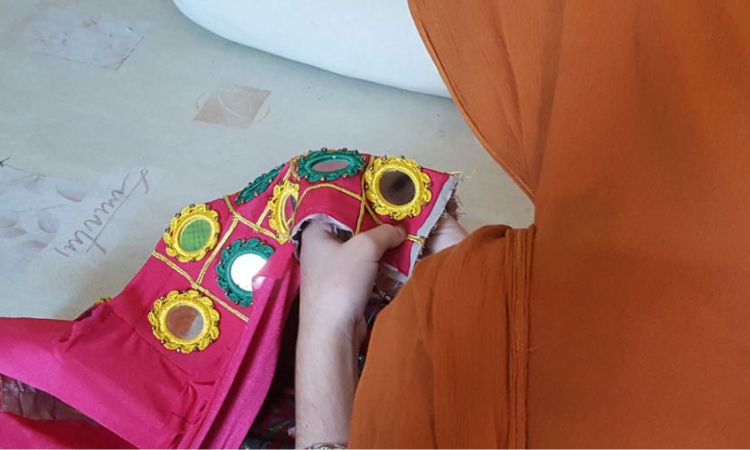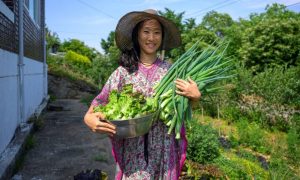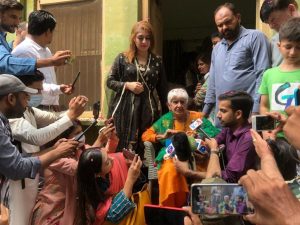ISLAMABAD: Standing in a long queue, Zuhra Mukhtar, an older woman, was waiting for her name to be called to get paid for her embroidery work at the office of an NGO, where she sells her stuff to earn some money.
Zuhra, in her 60s, is compelled by circumstances to work hard to meet her day-to-day expenses. She is a widow and mother of three sons, who are daily wage workers and bear the expenses of their own families.
“My sons are very obedient, but they don’t earn enough money to support me because all are married and have kids to feed. They don’t get work daily and often return home empty-hands,” she said.
Zuhra, who lives in Dhoke Kala Khan Rawalpindi and hailed from Kohistan, left her native town to save her sons from an old rivalry, but she lamented, “Now, we are dying every day due to poverty”.
On alternate Saturdays, home-based workers from different localities visit the NGO office to get paid for their work, which is at most Rs1000 to Rs1500. Though this amount may be minimal, many workers work hard for two weeks to get it.
She has excellent skills in hand embroidery and takes less time to complete more shirts. Showing her hands wounded with a needle, she said, “I have been doing this Bharai Tanka since childhood and learned it from my mother. Therefore, I could complete four shirts in a month and get four to five thousand rupees a month, depending on the design of the work.” Zuhra is now taking work home for her daughters-in-law as their husbands don’t allow them to work outside the home.
Another home-based worker, Bisma Jan, was sitting on a mat on the floor of the main hall of the NGO’s office, and the needle in her hands was quickly moving on the fabric to complete an incomplete shirt as she had to deliver the order to get paid. She worked on a lawn shirt piece, making shadow work with multicolour threads and needles.
Sharing her story, Bisma said she was grateful to the NGO offering her work and many other home-based workers. She admitted they didn’t earn much for their hard work but had no option. “I could manage to earn five to six thousand rupees per month because I also take work for many other home-based workers, who have no access to any NGO or other organisations to sell their work,” she noted.
Bisma lives near Sadar Rawalpindi and helps her husband financially. She learned this art from her mother-in-law, who used to work for the same NGO, and now when she is old, Samina has taken up this responsibility to run her family’s expenses.
Many colourful and trendy dresses showcased on the wall of the hall and were ready to deliver at their boutique. These dresses were beautiful as they were trendy with a traditional touch of hand embroidery, but the price tags showed high prices. Each piece was from three thousand to fifteen thousand rupees according to the volume of the colorful embroidery.
Home-Based Workers Contributions to the Economy.
Home-based workers are contributing a lot to the economy of Pakistan as they are doing a tremendous job by locally producing homemade items, such as needlework, embroidery, quilts, etc. Unfortunately, in the absence of any national policy, they are being exploited by many in the country.
Most home-based-worker women interviewed shared that they have no other platform to sell their products and don’t have enough resources to produce them.
NGOs have qualified designers who decide on the work, colour combination, and stitching pattern, and after cutting fabric per piece, it is given to workers as per their expertise. The designers also decide on even color contrast. Home-based workers are not paid per working hour but paid per piece, and it takes them a week to two to complete only one piece, for which they get 1000 to 1500 rupees.
According to HomeNet Pakistan, an organization working on home-based workers in Pakistan, there are 20 million home-based workers, of which 12 million are women. And most of the home-based workers are engaged in the garment and textile sector.
The organisation was training women to initiate their online businesses and have direct access to the market.
An official said: “Almost 45 women who have initiated their online business are earning around 30 to 40 thousand rupees per month.” She said that the government should establish trade facilitation and skill development centres in rural areas as per the existing skills of rural women to help improve their economic condition.
According to the UN Women’s Status Report 2016 on Women’s Economic Participation and Empowerment in Pakistan, women account for 65 percent of the PKR 400 billion (USD 2.8 billion) that HBWs contribute to Pakistan’s economy. However, most receive low wages and are denied legal protection and social security.
Both the Ministry of Labour and Manpower and the Ministry of Women Development had formulated a policy before their devolution in June 2011. After the devolution, this policy now rests with the provinces. Provinces are still working on home-based workers’ bills and legislative procedures, and Punjab and Sindh governments notified home-based workers policies in 2017.
























